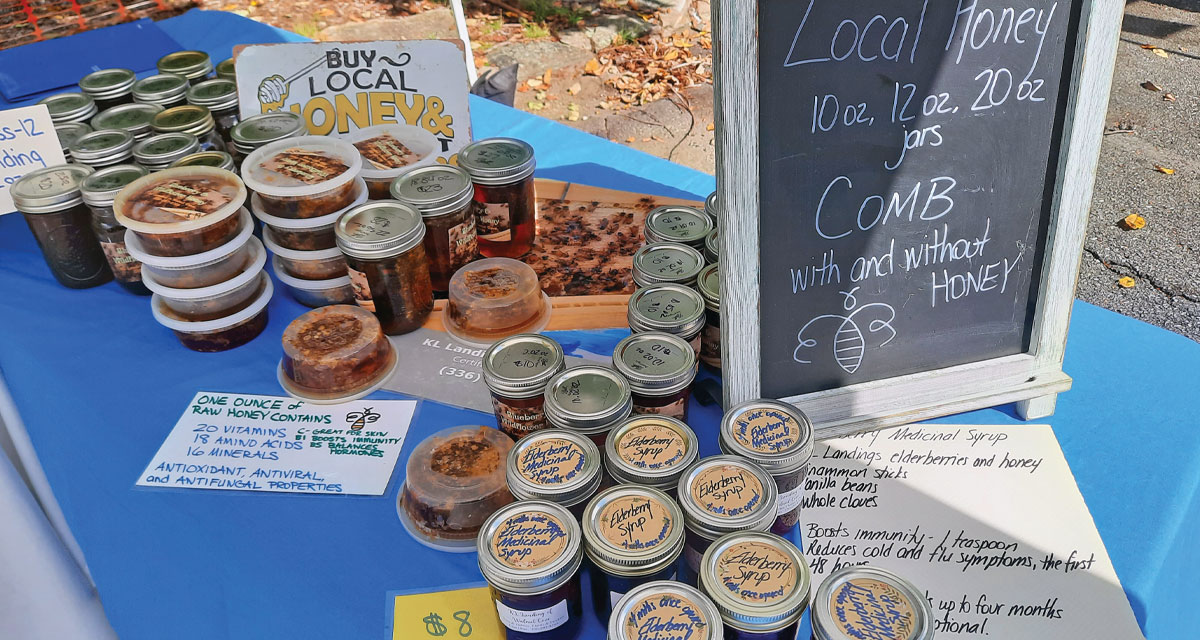From the outside, a farmer’s market is an appealing attraction, combining colors, wording, and an accurate display to showcase a vendor’s goods. You’ll find a tent, covered tables, a banner, baskets, and bags in an array of materials and colors, and some items presented on an elevated platform. The woman or couple standing behind the table appear enterprising, by selling homegrown, farm-raised, artistic, or handmade products as a business opportunity; yet, there’s plenty more behind the scenes!
Getting Started
More than 12 years ago, my husband and I dreamed of our property turning a profit one day. We planted an orchard, over 50 blueberry bushes, 30 grapes comprising three varieties, and had a daily supply of protein-enriched, multi-colored eggs. The garden produced fruits and vegetables across two and sometimes three seasons, while my husband canned. Since then, we’ve fed the wildlife hundreds of pounds of food. And our dreams continue to expand, now including an apiary, greenhouse, greater varieties of fruit trees, and a more extensive garden. With available plants, produce, fruit, fresh eggs, and jars of honey with and without the comb, I finally felt ready to embark on a new chapter, and tossed my hat into the ring in the role of a vendor.
Day One
A ten-minute drive offered the opportunity to sell my items locally at an established market. The school year had ended; recitals and sports seasons concluded. It was a Saturday morning in late May; I rose at 6:30 AM, intending to arrive by 9 AM with my table, honey products, produce, plants, lockbox, lunch, and bottle of water. The idea of taking 2.5 hours to arrive sounded possible, but, in reality, preparation required many hands and specific jobs. My husband and daughter joined me to pick vegetables and fruits, wash, pat dry, and place in large-to-small stainless-steel bowls. With pricing finalized, I arrived last at 10:30 AM. I was welcomed with smiles and introductions by the local men and women, who also saw the market as a chance to produce a worthy product and reap the rewards of a side-income.
The Learning Curve
As presentation leads to the goal of sales, vendors invest in every aspect of their space. From the tent to the table to the signs is just one part. It’s more than the seeds and pots, fertilizers, trays, or five-to-ten bulk-rate, quality ingredients, containers with lids, and eye-catching labels; each product requires a financial decision. Short-cuts do not win return customers. The small-business vendor sits weekly in chilly to unbearably humid conditions, because of an unwavering belief in his or her products. When sales are made, it confirms the reason a vendor has accrued innumerable hours in a potting shed, greenhouse, garden, kitchen, living room, or in planning online for the future, another season, or expanding options, while reaching for the goal to improve someone’s day, health, or happiness.
Interacting with the Public
Sitting and awaiting an exchange comes naturally to a young child or adult in the form of a smile, wave, or raised arm. Curiosity brings a wide range of ages into my tent. All it takes is a humorous line like “Honey, it’s a sticky business” or “Soap-making isn’t exactly a clean endeavor,” to initiate a conversation, or at least, prompt a smile. I can recall a young boy, age five, who said with bright, wide eyes, “I love plants,” as his parents kept walking. Before he ran off, I whispered, “Me, too!” More than just an exchange of greetings, I love meeting people with a like-minded interest in beekeeping, gardening, or natural products. For those who linger, engaged, it’s tempting to ask, “Do you have time to sit down and talk?” Markets are mutually beneficial for exchanging ideas and learning about successful techniques, applications, best practices, and horror stories. As a result of Saturday’s interaction, the confirmation of this fact arrives in a phone call, text, e-mail, or customer return!
Setting and Packing Up
Arranged meticulously in my SUV are tables, a 12×12 tent, platforms, chalkboard signs of various sizes, numerous heavy, snappable containers, and sometimes coolers. Along with employment, a child at school, house responsibilities, and pets, the endeavor consumes hours of time ordering the ideal items and making the product.
- Soap, for instance, takes under two hours to make and four to six weeks to cure.
- Most salves and balms require two batches to ensure a solidified outcome.
- Inflation, or the lack of obtaining a product, drives the price up. Many vendors drive a great distance to save on hefty shipping costs.
Think of your favorite farmer’s market vendors this holiday season! They’ll provide great deals for multiple items, while offering unique packaging. Reach out today!























